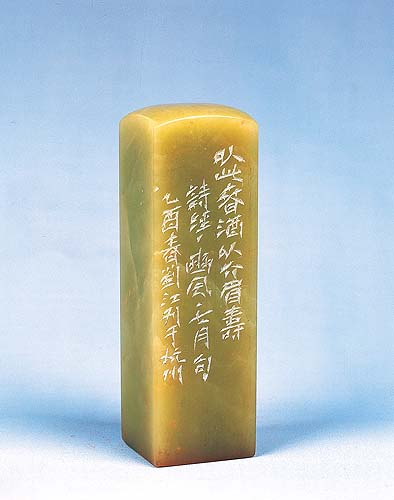|
 |
|
ART IN STONE: An artpiece of engraver Liu Jiang, a consultant for the Chinese Academy of Seal Engraving. Liu engraved two sentences of a poem of Classic of Poetry, China's first ancient poem collection (NANG CHAOFENG) |
On October 31, an exhibition with the theme of Beautiful Land opened in the Palace of Prince Gong in Beijing. It is an exhibition of seal engravings to celebrate the inclusion of this traditional Chinese art on UNESCO's intangible cultural heritage list.
The good news came early on the morning of October 1 from a UNESCO meeting held in the United Arab Emirates. Luo Pengpeng, Executive Vice President of the Chinese Academy of Seal Engraving (CASE), who has been in charge of China's world heritage applications since September 2008, said she felt happy and greatly relieved at the news.
"It was really hard work," said Luo, who had only 10 days to finish all the application materials, including a 10-minute video, 60-minute audio presentation and texts introducing seal engraving art. "The group has only about 10 people and we went all out in our preparations."
Why seal engraving?
 |
|
ENJOYING EXHIBITION: Xiong Guangkai (right), former Deputy Chief of the General Staff of the People's Liberation Army and Zhou Mingwei, President of the China International Publishing Group, enjoy the Beautiful Land Seal Engraving Art Exhibition on October 31 among other distinguished guests (COURTESY OF PHOTOTIME) | "With a history of more than 3,000 years, seal engraving has played a very important role in Chinese culture and is still in practical use nowadays," said Luo, who regards its practical value as the main reason why seal engraving has been handed down for such a long time.
At the very beginning, seals, which are made using knives to engrave an ancient calligraphy style into stones, were used by people as identifying marks, much like signatures today. In the 13th century, this art became more and more popular. It began to incorporate some artistic elements and gradually developed into three types that still exist today. One is purely for artistic use, such as engraving poems in stone; one is purely for practical use, such as the seals used by governments to stamp documents; and one is for both, such as the intricate seals artists use to sign their artwork.
"All forms of art should have social functions, otherwise they won't last long," said Luo. "It is one of the most important elements in UNESCO's view."
However, since the characters engraved in the stones are of ancient calligraphy style, most people today can't identify them and thus categorize seal engraving as a highbrow art. "This is a problem in the spread of this art," said Luo, who has made efforts in recent years to develop more social functions for the seals and make other changes to increase their popularity.
"For example, when the seals are used on teapots, they always appear on the bottom," said Luo. "I moved them from the bottom to the teapots' bodies to make them more visible."
In addition, more Chinese companies are using seals for their company or brand logos in order to show their Chinese cultural characteristics. In 2008, the logo of the Beijing Olympics, a seal with the image of a taiji practitioner, became popular all over the world.
"How to combine seal engraving art with our daily lives is an issue this generation of seal engravers should consider under the new historical conditions," Luo said at the exhibition's opening ceremony.
|
